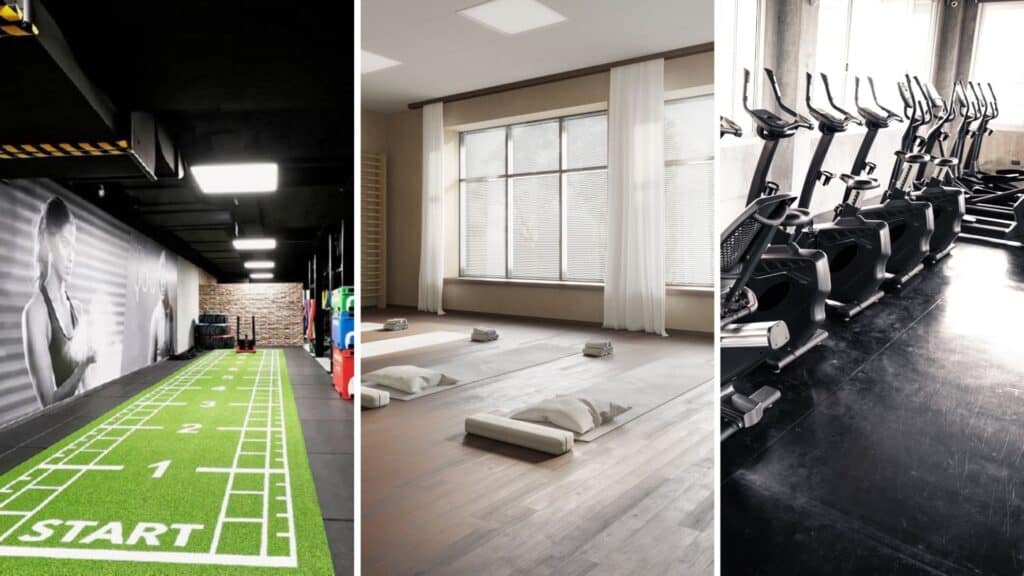The Importance of Specific Flooring for Different Gym Zones (Intro)
When people think of a gym, they tend to think of a space filled with weight machines and treadmills. These days, however, gyms have evolved into multi-activity fitness clubs that provide a vast array of equipment and apparatus. From functional HIIT to free weights to ellipticals, users will move from one zone to another to meet their fitness goals. But do these different gym zones require different flooring?
It depends on several factors, including layout, budget, and safety. In a well-planned modern facility, the right flooring solution will solve problems before they arise. It doesn’t necessarily mean that different activity zones must have different flooring; it just means that a solution may suit a specific need.
In a modern gym facility, people expect a cardio zone, a free-weight zone, a ‘functional’ zone, a weight machine zone, and a stretching zone. Planning your gym, you’ve probably pictured the different zones and how they interact. It’s easy to let your imagination run wild when planning your perfect gym. Before you get carried away, you must consider where a specific zone could work relating to the impact it generates.
Optimising Your Layout
Whether you’re re-arranging the equipment in an existing facility or opening a new gym, optimising the space will help you achieve the best possible outcome. Once you work out the optimal layout, choosing the appropriate flooring for each zone becomes easier. Critically, you must consider different flooring for different gym zones where the following applies:
- Neighbouring premises will be affected by a particular zone
- A zone promotes noisy activity or high-impact training methods
It is likely your gym will somewhat impact neighbouring premises, and you will receive complaints. Noise and vibrations will be a big problem if you don’t plan accordingly. Instead of reacting to the issue, position your lower-impact zones strategically to minimise potential disturbances. If that isn’t an option for your space, consider using a shock-absorbing, soundproofing flooring material where appropriate.
Thicker flooring absorbs shock and sound and is the best solution for zones that endure heavy impacts. For example, a noisy free-weight area will benefit from having more protective flooring. Zones that encourage high-impact training, like a ‘functional’ area, will also need a different flooring solution where safety and noise impact is concerned. Kettlebells, plyometric boxes, battle ropes, and sandbags generate significant noise.
Finally, there is a case for constant noise. The treadmill is ever-present in any gym. From open until close, the droning thumps don’t stop. Luckily, many models come fitted with levelling screws that also serve as dampening pads, removing the need for other soundproofing measures. Cardio zones tend to have PVC or vinyl flooring because other machines, e.g. exercise bikes and ellipticals, don’t generate significant noise.

Budget Constraints
Opening or refitting a gym is a costly undertaking. Many aspects demand diligent investment – not least the design itself. State-of-the-art equipment will take priority, while flooring is often an afterthought. Consequently, does your budget have the capacity for multiple flooring solutions?
Logic dictates that a single flooring material – like PVC or vinyl – throughout your gym would be cheaper than having different materials in smaller quantities. It makes sense because the more you buy, the cheaper it gets per square metre, right? Not necessarily, when factoring in reducing impacts and minimising disturbances. Case in point: multiple thick rubber lifting mats will bring extra costs that could outgrow a different zonal flooring material.
Laying an entire gym with thick rubber tiles is uneconomical. If you allocate a respectable amount of your budget to flooring, you can choose a suitable material for each activity zone. While it’s sensible to position high-impact, noisy zones away from neighbouring premises, the right flooring solution should enable you to plan your gym as you wish. After all, gym zones must interact in a fluid and logical way.
Safety Considerations
In a hazardous environment, safety is paramount. Before deciding whether to use different flooring for different gym zones, you must assess the risks. The very nature of a gym means that users become weary and exhausted. Therefore, it’s critical to prevent accidents and injuries. Installing flooring transition strips, for example, will reduce the risk of somebody catching the edge of a tile and tripping over it.
In addition, you must consider the type of flooring related to the conditions of the activity it serves. A vigorous cardio workout or functional HIIT session generates heavy sweating and potential water spills. Where this is likely, it’s wise to consider easy-to-clean flooring. Mopping up spills will reduce the risk of slipping and injury.
Above all, different flooring zones will provide better safety to gym users. Thick rubber flooring in a free-weight zone will reduce the risk of weights bouncing off hard flooring and landing on feet or shins. Medium-thickness flooring will give a functional area a good level of impact cushioning without loss of stability. And non-slip synthetic flooring makes cleaning up sweat and water spillages easier in cardio and weight machine areas.
Pros and Cons of Different Flooring in Different Gym Zones:
| Pros | Cons |
| Activity-specific applications Better impact protection for users and equipment Mitigate disturbances to neighbours More durable materials for heavy-use areas | Potentially more expensive Less agile, with fixed zones being difficult to relocate Potential risk of trips if not correctly installed |
Pros
- Activity-specific applications
- Better impact protection for users and equipment
- Mitigates disturbances to neighbours
- More durable materials for heavy-use areas
Cons
- Potentially more expensive
- Less agile, with fixed zones being difficult to relocate
- Potential risk of trips if not correctly installed
Summary
In essence, it makes sense to give serious thought to using different flooring in different gym zones. The fundamental point is that different flooring materials will enable the safe practice of zone-specific exercises. It will reduce noise and damage, which is a necessity, but the safety of the gym user should be at the top of any gym operator’s list of priorities.
If budget is your limiting factor, consider this as a final thought: 100 square metres of vinyl flooring may be cheaper than 100 square metres of 40mm rubber tiles. But sooner or later, when you have to cover the vinyl in your free weights area with an additional 100 square metres of thick rubber tiles – because people keep dropping weights – you’ll kick yourself at the oversight while smarting at the extra cost.
If you have any questions about what you’ve read and are interested in finding out more, please don’t hesitate to get in touch.
To comment on the article, please proceed to the Telegram post. We encourage you to read our comprehensive article “How To Choose Gym Flooring“.
Disclaimer: The opinions and positions expressed in this publication are those of the authors and collaborators and do not necessarily reflect the views or policies of the professional fitness community.

